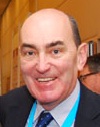85 attendees took the opportunity to digest presentations given by technical experts in RF and microwave technology as well as networking during the second annual Interlligent UK RF and Microwave Seminar, which took place at the Cambridge City Hotel, Cambridge, UK on Tuesday 14 October.
In welcoming those present Oren Hagai, CEO and Founder of Interlligent RF & Microwave Solutions, described the attendance as being a 3 dB improvement on the inaugural event held in June 2014 – soon after the UK division of the company had been formed. He vowed to continue efforts to raise the company’s profile in the UK, increase its test and measurement solutions business and develop other activities including RF training, RF components and systems, RF engineering services and entrepreneurial RF Incubator ventures.
The seminar programme, chaired by Helen Duncan of MWE Media, began with Millimetre-Wave Technologies and Applications –Finally Fulfilling Their Promise by Prof. Ian Robertson, University of Leeds.
He began with a brief history of the development of millimetre-wave technology, expressing a personal regret that he had not thought of the idea of MIMO! He emphasised that the millimetre-wave frequency range is especially important for communications and sensing and will feature strongly in future generations of mobile communications standards. He asserted that after the long-since forgotten GaAs versus silicon debate in the 1990s, silicon has emerged stronger than ever, challenging the III-Vs even in the millimetre-wave range.
Looking forward Robertson identified significant challenges including the urgent need to push down the cost of millimetre-wave systems and the desire to push the performance envelope so that SiP solutions can be employed for systems beyond 100 GHz, including terahertz systems. He also expects SiP/SoS technology to finally deliver the explosion in applications of the millimetre-wave and terahertz bands for applications such as 5G+, IoT, M2M communications, biosensing, imaging, security screening, etc.
Next up was Michael Crowley of Farran Technology who considered: The Search for Bandwidth – 60 GHz Communications. He offered a review of the 60 GHz communications market and the difficulties of developing test equipment suitable for such systems. He considered the development of millimetre-wave technology before focusing specifically on backhaul. He identified that there was most commercial interest in the V-Band and E-Band, with a little in the W-Band. He then considered cost effective test and measurement solutions for high frequency applications and Farran Technology’s development of 60 GHz communication link frequency extenders, finishing with a video demonstration of their operation.
After a break for coffee and networking Dr. Danny Webster of Lime Microsystems presented the serious subject of: Field Programmable Digital and RF technologies driving innovation in wireless networks with dry wit. He presented the concept of Field programmable RF (FPRF) technology where flexibility is extended from the digital to the RF domain. He defined FPRF technology and the concept of Software Defined Radio. Webster offered use cases and application areas where such technology is making a significant impact and identified where the Open Source community is getting behind the technology and driving innovation.
Chris Potter of Cambridge RF abandoned dry wit for all out humour in his presentation titled, Making RF Designs Work. By following the polar opposite approaches taken by cartoon characters: Randy of Classic Design Services and Chuck from Shoestring Enterprises he offered a light-hearted view of the possible pitfalls that can occur if RF design is not approached with best practice in mind. On a serious note he offered true-life illustrations of a GPS module front-end, an oscillating PA, and grounding and decoupling an RF chip.
The break for lunch not only offered sustenance but also the opportunity to network and visit the adjacent exhibitor area featuring demo tables featuring Farran Technology, Flann Microwave, Intelliconnect, Interlligent UK and Plextek RFI.
The afternoon session kicked off with Prof. Steve Cripps – or should that be Steve Quips! – of the University of Cardiff delivering: RFPA Design Flow: the Great Debate in his own inimitable, entertaining and informative style. He charted the history of both the physical and behavioural approach to PA design. Disappointing for those who look forward to Cripps challenging convention he admitted to only one ‘controversial’ slide, which covered behavioural modelling using X-parameters and stated: “Lack of co-operation between modelling and circuit design cultures is all too evident”. He concluded that behavioural modelling is new and may have a role to play but is as yet unproven in value for industry designers.
Next was Liam Devlin of Plextek RF Integration who offered an insight into, Designing GaN PA MMICs. Starting with the acknowledgement that there is an increasing number of commercially available GaN foundry processes and that the realization of custom GaN PA MMICs is now a practical option for many applications he offered an overview of the structure and operation of a GaN HEMT. He explained how to design a GaN PA MMIC and gave design examples of three applications each using a different commercially available GaN foundry process: a 15 GHz PA for LoS links, a 2 – 18 GHz NPDA for broadband operation and a 25 W X-Band PA for radar applications.
After the final coffee and networking break of the day the paper titled Harmonic Load Pull Investigations of High-Efficiency GaN Power Transistors by Mauro Marchetti of Anteverta (a Maury Microwave company) offered an overview of different harmonic load-pull topologies. He gave examples of how harmonic load-pull can be used to search for the optimum terminations in a fast and effective manner. This allows a drain efficiency as high as 90% at 2 GHz, while delivering 3.5 W of output power for a 1.2 mm device gate width to be achieved. Marchetti explained that further X-band analysis yields a PAE >65 % over the entire wafer.
Winding up the seminar Oren Hagai thanked all the participants and organisation team before inviting everyone to the third Interlligent UK RF and Microwave Seminar in 2016. Finally, a prize draw saw a drone presented to Emiliano Mezzarobba of Cambridge Consultants.

